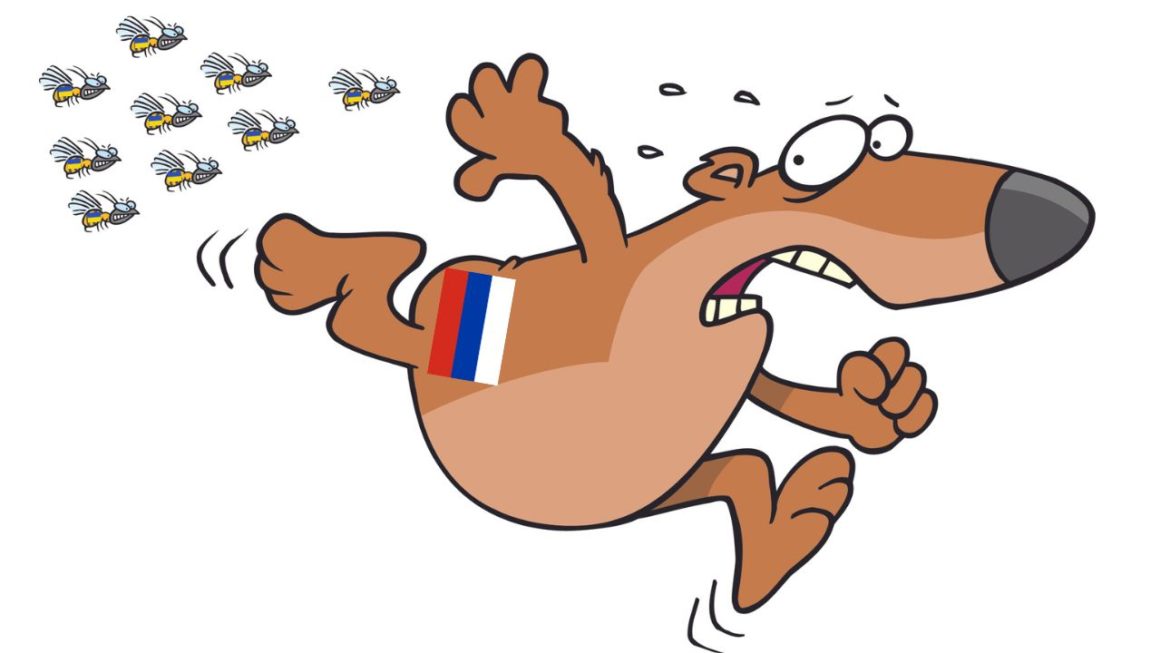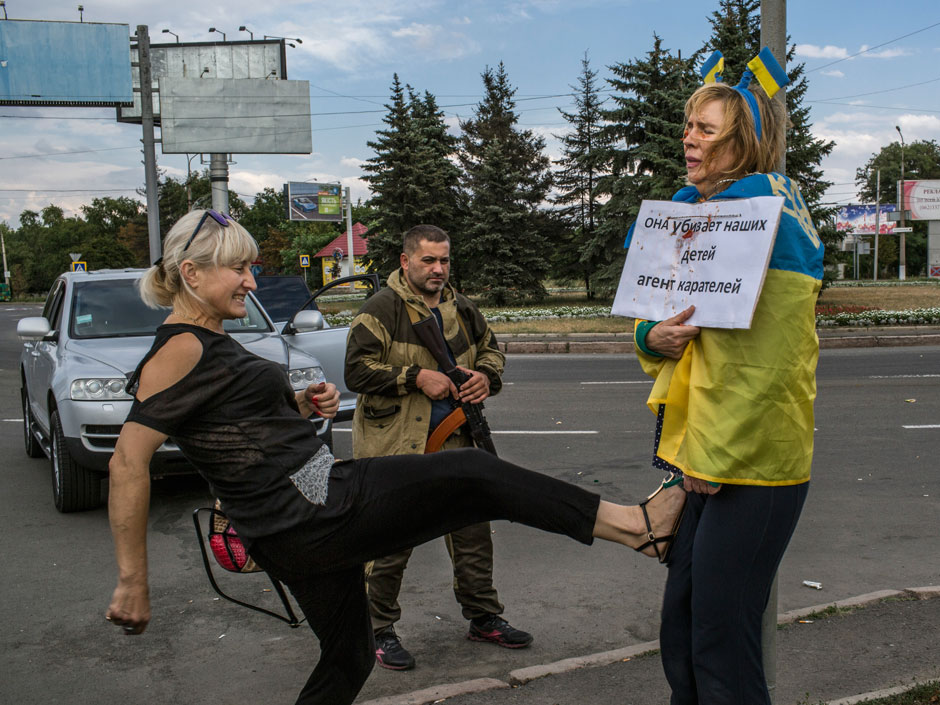Can Putin's lies be effectively debunked in a way that reaches a wide Western audience? In this information war, the West could learn from Ukraine’s experience battling Russian disinformation for over a decade.
A new report “How Ukraine Fights Russian Disinformation: Beehive vs Mammoth” by Jakub Kalenský and Roman Osadchuk details effective Ukrainian tactics. Western media should study its vital lessons. Chief among them: Russia's military aggression invariably follows its propaganda efforts.
Ukrainians have much more experience fighting Russian propaganda and disinformation than Westerners. Over the decade since the Euromaidan protests in 2013, Ukraine has identified best practices in combating Russian lies.
The new report "How Ukraine Fights Russian Disinformation: Beehive vs Mammoth" highlights 10 key lessons from this fight. Not every idea worked well, but through trial and error, Ukraine learned which tools and methods are most effective.
It is possible to substantially curb the sway of Russian propaganda, but democratic nations must first take the threat far more seriously. That is the essential initial step; everything else will follow. Understanding the danger plus mustering the determination and will to counter it are fundamental.
On paper, comprehension of the threat seems to exist.
The World Economic Forum declared disinformation the most significant long-term risk just weeks ago. In 2018, the EU Action Plan against Disinformation termed Russian disinformation the greatest threat to the EU.
Yet no matter how often Western policy documents acknowledge the "number one threat," the action and resources do not materialize. European counter-disinformation efforts remain understaffed and underfunded to the point they could not even spot a disinformation wave.
So Russian propaganda campaigns keep succeeding: as multiple polls reveal, the Kremlin's lies still sway a substantial portion of European societies.
Billions vs. Millions: the Kremlin's asymmetric advantage
This stands in stark contrast to the Kremlin's approach. As documented by Oscar Jonsson in his book The Russian Understanding of War, Russian strategic documents and top military leadership have gradually introduced greater importance of non-military measures like information confrontation in modern conflicts, to the point they are considered even more important than military ones. Furthermore, Russians implement their strategic plans. Elements of the Kremlin's 2013-2014 information aggression against Ukraine and 2016 efforts against the US had been outlined theoretically years prior - as Jonsson notes,
"It is critical to understand Russian theorizing about war because Russian conduct often follows it."
As Volodymyr Yermolenko eloquently put in the interview for our report:
“The EU saw the information space as a big marketplace where you come, sell your goods, buy other goods, and everybody’s happy. The Russians, on the other hand, treated the global information space as a battleground. It’s not a market where you come to sell your goods. It’s a battlefield where you shoot, and you try to avoid being shot.”
The very close connection between information and military domains in the Kremlin worldview is tangible, not abstract. Russian propagandists have received medals for participating in wars - not for reporting, but for active engagement. This happened in Syria seven years ago and again after Russia's 2022 full-scale invasion of Ukraine. The Kremlin views these mouthpieces as part of their army, a perspective lost on the West.

We see the emphasis on information warfare in Russian strategic documents translated into billions of dollars funneled into this fight.
Per the US Global Engagement Center, the Kremlin spends $4-6 billion annually, which does not include budgets for RT and Sputnik. Earlier estimates talked about circa $2 billion annually. However, this figure covered only the official Kremlin pseudo-media outlets and did not cover the resources of various GONGOs, foundations, gray outlets, the army, and secret services, the embassies, the troll factories, and other actors who are involved in disinformation and propaganda (a lot of this budget is secret).
Thus, we can only be sure that the $2 billion is minimum spending, and the overall sum will likely be several times bigger.
Meanwhile, European teams countering this threat are comparatively tiny. The most visible EU effort documenting and rebutting Russian lies, EUvsDisinfo campaign, now has a €12 million annual budget. It used to be significantly less, and in the first three years of its existence, it had no budget at all.
As Richard Stengel's Information Wars highlighted years ago, Western countries remain outnumbered and outmessaged by malicious information actors.
The situation has been similar across the Atlantic as well. As Richard Stengel highlighted in his book Information Wars years ago, Western countries remain vastly outnumbered and outmessaged by malicious actors weaponizing the information domain.
The tools exist, if only the West had the will
It is difficult to determine whether the inadequate response stems from a failure to grasp the gravity of the threat or a lack of determination and will to fight back. However, overcoming this initial obstacle seems the most challenging.
Once the West realizes Russian disinformation's threat and transforms that recognition from mere words in policy documents into concrete action and resources, a whole universe of countermeasures suddenly emerges. The experience of Ukrainians, who have already tried most of these countermeasures in the last decade, can help identify the most essential and effective ones.
In the report, we identified the basic tasks and the conditions without which it is impossible to do anything else. These are, among others:
- extensive monitoring;
- rapid debunking;
- prioritizing action over contemplation and bureaucratic procedures.
We highlighted the importance of numbers – be they in human resources, financial resources, the various countermeasures being undertaken, or the need to repeat the tasks.
We covered the coordination and overlap between the various efforts and the necessity to involve civil society because civil society can do many things that governments cannot.
We also talked about the role of planning, the usage of humor in countering disinformation, and the efforts to not just boost the defense but also limit Russia's capability and will to be aggressive.
These tools are sometimes considered to be controversial in the West – many of our Ukrainian interviewees actually saw them as the most important part of the toolbox.
But all the various Ukrainian activities countering disinformation, undertaken daily by thousands, are only possible thanks to an initial understanding of the breadth and depth of the problem. The understanding means that the action does not stop at writing a sentence or two in policy documents.
It might seem that Ukrainians gained this understanding because of the proximity of the Russian threat. They have witnessed firsthand how years of information aggression paved the way for military aggression. The ongoing Russian propaganda aimed at paralyzing Ukraine's allies has led to slower weapons deliveries and, thus, to more victims in Ukraine (see here or here).
However, Ukrainian efforts to counter disinformation began well before the full-scale invasion in 2022. They grew significantly after 2014 when Russia annexed Crimea and occupied part of the Donbas region of Ukraine. The Ukrainian resistance in 2022 was far stronger than in 2014 – both militarily and informationally. Ukrainians didn't waste the relative calm between 2016 and 2022 (impossible to call it "peace" in hindsight) and prepared.
The countries West of Ukraine had better learn from the Ukrainian experience and tackle the problem of Russian information aggression seriously sooner rather than later. Building a capable counter-disinformation ecosystem takes time. And as the increasingly common warnings about a Russian invasion of NATO countries tell us (see here or here) – time is something that Europe might be running out of.
This text represents the opinions of the authors only and does not reflect the position of their employers. Featured image: Depositphotos, with edits by Euromaidan Press
Read more:
- Genocide of Ukrainians is reasonable, Putin tells Tucker Carlson
- Lysychansk “bakery” strike: how Russian propaganda duped Western media
- Russian war propaganda: strategic/tactical narratives, and their audiences
- Report: Western media underestimate Russian propaganda’s effectiveness
- A guide to Russian propaganda





